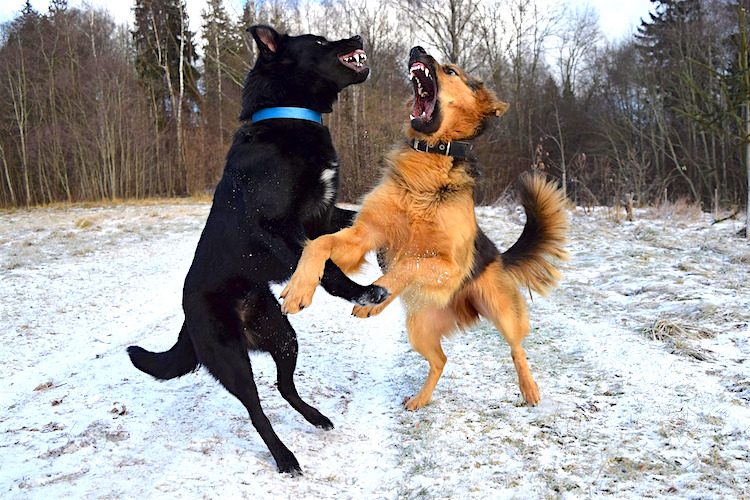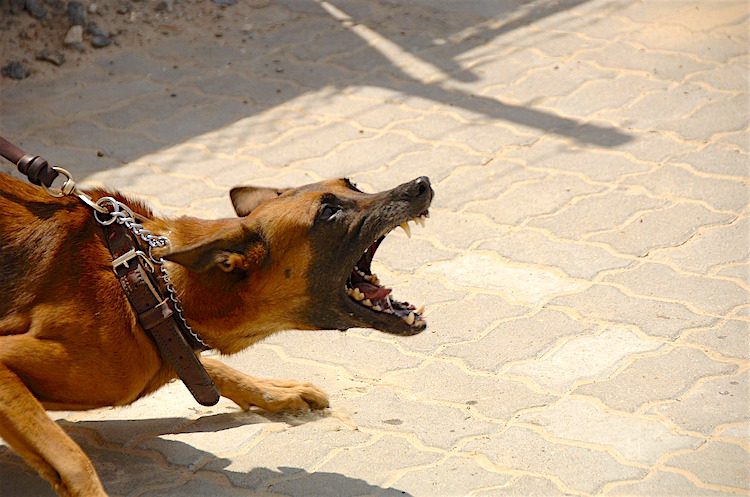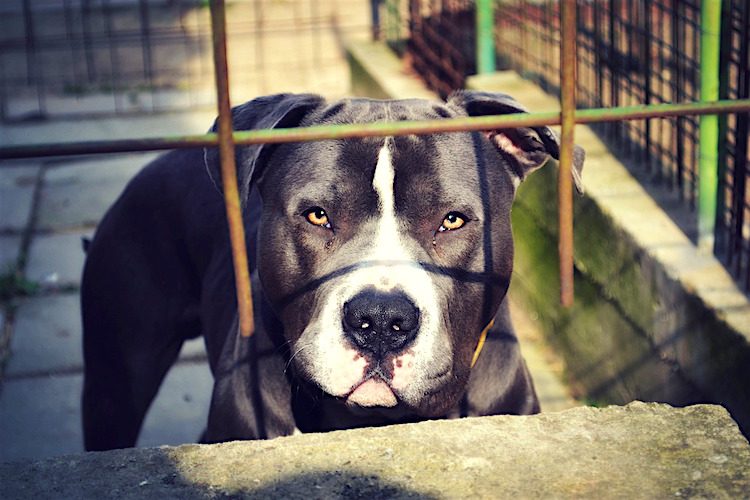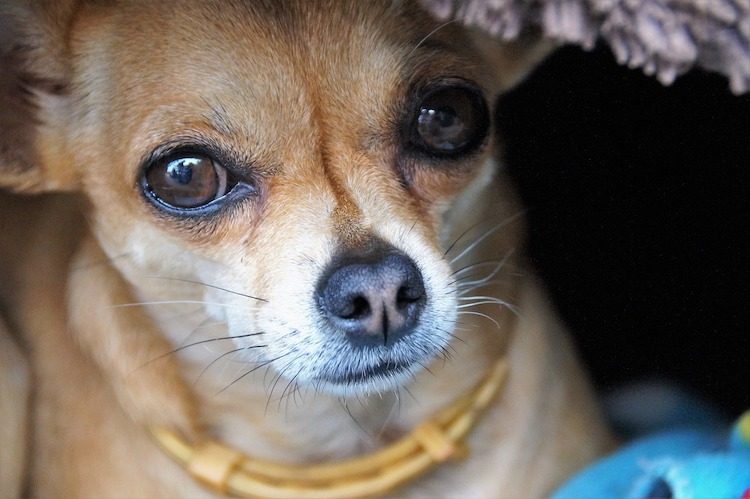
Understanding Most Aggressive Dogs’ Behavior
Nature versus nurture: It’s an age-old debate, especially when applied to the question of who the most aggressive dogs are.
Any dog who endures an abusive, neglectful, or life-threatening situation can become aggressive. Does that mean these are bad dogs?
Absolutely not.
However, some dog breeds were bred for centuries to become protectors and hunters, and those traits are stamped on their genes. This doesn’t mean that every animal in the breed is aggressive, but simply that the potential is there (and even in what are thought of as the least aggressive dog breeds, you’ll find some outliers).
The point is this: Any dog can be aggressive, and that’s where “nurture” comes in.
Proper training is vital when it comes to helping dogs cope with anxiety and aggression. Moreover, training ensures the safety of your dog and anyone who handles the dog.
Dangerous vs. Aggression
“Dangerous” and “aggressive” are not always comparable — at least in the statistics.
Several small dogs often display more aggressive tendencies than larger breeds, yet it’s the larger breeds that always make the “dangerous dogs” lists and have their bites tracked, sometimes skewing the statistics regarding what type of breed has the most attacks.
“Damage potential” is a term that comes up with insurance companies when these companies are deciding which dogs to place on their “dangerous dogs” list:
- Several breeds such as wolf hybrids, Rottweilers, Dobermans, pit bulls and pit bull mixes, German Shepherds, and Akitas often make the list.
- Yet Chihuahuas, dogs who can and do bite often, are nowhere to be found.
The reason for this disparity? Damage potential.
Damage potential is what an insurance company will use to evaluate a dog breed. They ask: How much damage will this dog cause to a person or property should they attack?
Obviously, a Doberman can do a lot more damage than a Chihuahua, so the Doberman makes the list.
Although this may seem unfair to Doberman fans and other large-breed lovers, it makes sense. Your Doberman may be the most sweet-tempered dog on earth, but other Dobermans may not — and they can cause massive damage.
The result of all this is that the larger breeds often get unfairly labeled as being the most aggressive dogs out there, when — in many cases — it’s dogs who barely reach their kneecaps who deserve the title of most aggressive dogs.

Why Dogs Display Aggression
The dogs who cause damage most likely do so because of their ancestry.
These dogs were bred to be workers, hunters, and baiters. Aggression was deliberately encouraged to get these dogs to perform their specific task better.
Centuries later, those traits are still coded into our dogs’ DNA.
Abuse, neglect, and poor training also play a large role in how any dog of any breed responds to their environment. Any dog can become aggressive under the right conditions. (Say it louder for the people in the back, right?)
When we’re choosing a dog to adopt, history is as important as the dog’s breed:
- Dogs who were allowed to exhibit poor behavior because of their small size often become aggressive, as they see themselves as the alpha.
- Dogs who were abused become aggressive out of fear.
- Dogs who were starved often become food-aggressive.
- Dogs who are not properly socialized often become aggressive to other animals.
- Lastly, people often push their dogs into aggression without realizing it.
Child parenting around dogs is critical. Don’t let your child hit, punch, pull tails, ride the dog or in any way harm or make your dog uncomfortable.
It may make for a cute Facebook video when your child is face-to-face with your dog, but dogs see direct eye contact and full-front facing as a challenge. The dog will be very uncomfortable with a child getting right in their face.
If you constantly let your children treat your dog as their personal jungle gym, don’t be surprised when your dog “suddenly snaps” and bites back. Chances are your dog had been telling you all along with their body language that they were uncomfortable, afraid, and unhappy.
We have the ability and the responsibility to teach our dogs appropriate behavior and response starting in puppyhood, and this can make all the difference. We can promote nurture over nature.
The Most Aggressive Dogs
Opinions vary on which are the “most” aggressive dog breeds. In no particular order, here are 5 breeds that make almost all the lists:

1. Pit Bulls
Let’s take care of the elephant in the room first: the pit bull.
The term “pit bull” is actually not a breed — it refers to the American Staffordshire Terrier, American Pit Bull Terrier, Staffordshire Bull Terrier, and American Bully.
There’s a lot of debate about pit bulls, and these dogs are often in the news having injured or killed someone.
Pit bulls attack by biting their target and then shaking their head back and forth, an attack style that can instantly lead to catastrophic injuries. These are also focused dogs, and many times they can’t be persuaded to release their grip.
What the news often neglects to report is whether there was a trigger for the aggression, so it’s difficult to say why the dog attacked.
The pit bull is descended from the English bull-baiting dog, which was bred to bite and hold massive animals such as bulls or bears. These dogs were bred to be aggressive, tenacious, and strong.
When bull-baiting was outlawed, breeders began crossing the bull-baiting dog with the terrier to make them quicker and more agile, which started the line of descent to the pit bull we know today.
Stepping back, we can see that the pit bull in all its various incantations today attacks the same way — bite, hold, and shake — and is dogged about maintaining the grip. When we look at the ancestry, we now can understand why.
Pit bulls can make wonderful, devoted, and loving pets. But it’s critical that their humans socialize, evaluate, and continually train them so that, in any given situation, the dog knows how they are to behave.
In 2017, pit bulls were responsible for 74% of fatal dog bites or attacks. However, there is one big qualifier: Often, dog breeds are misidentified, especially in shelters. So some of these attacks may have been by dogs with little or no “pit bull” in them.
The next dog on our list consistently ranks as much more aggressive than the pit bull — we just rarely hear about it.

2. Chihuahuas
Chihuahuas are strong-willed, extremely intelligent dogs.
They are responsive to firm and positive reinforcement-based training and usually turn out to be friendly, curious, and adventurous.
However, the Chihuahua can also be dominant, jealous, aggressive, and untrusting. And when these traits present themselves, a Chihuahua has no problem using those tiny jaws on their target.
Chihuahuas are among the oldest dog breeds in the world and originated in Mexico, prized for their combination of small size and courage.
Chihuahuas are alphas — their intelligence demands no less. Therefore, you need to invest time in training the Chihuahua just as if they were a large-breed dog instead of allowing behaviors — like jumping up — that would not typically be allowed with larger breeds.
Many people think it’s cute when a small dog exhibits stubbornness or refusal to obey. Reimagine the Chihuahua at about 60 pounds, and it’s not so funny anymore.
So, the mentality is the same regardless of the size of the dog: Proper training is key. Don’t allow aggressive or dominant behavior, even if you find it “cute.”

3. Wolf-Dog Hybrids
A dash of common sense will tell you why these animals score high on the aggression index. Wolf-dog hybrids are just what they sound like a combination of wolf and dog.
Wolves and dogs are interfertile, which means they can mate and produce offspring, and their offspring are known as wolf-dog hybrids (regardless of the breed of dog who mates with the wolf).
Dogs have centuries of domestication at their back, but wolves have evolved with none. When wolves reach sexual maturity, their behavior changes. In the wild, this is when they begin asserting themselves as individuals within the pack.
Wolves will challenge the pack leader to achieve a higher position in the pack. In the domesticated household, you are the pack leader, so you might see assertive or aggressive behavior where there was none before:
- Territory might become increasingly important to your wolf-dog hybrid.
- You might start seeing urination inside the house as the dog marks their territory.
- Strangers may elicit a much stronger response from the wolf-dog hybrid than previously seen.
However, mating between wolves and dogs is consistent in only one area: It produces highly inconsistent offspring, also making it one of the most unpredictable dog breeds.
Some wolf-dog hybrids are just as laid-back as you are, while others seem to be taking all their cues from The Call of the Wild. Even animals from the same litter can demonstrate wildly differing behavioral traits.
So it’s up to you to do intensive research on both dogs and wolves before bringing a wolf-dog hybrid into your home.
This is not a pet that typically does well lying around on the sofa all day. They require lots of consistent and repetitive training as well as plenty of exercise and mental stimulation.

4. Dachshunds
That’s right — here’s another small pup on the list of most aggressive dogs to prove that size is no indicator of aggressive tendencies.
According to a study published in the journal Applied Animal Behaviour Science, Dachshunds rank among the most aggressive dog breeds in terms of aggression against both people and other animals.
Like the Chihuahua, this is likely because the Dachshund’s size makes it easy to overlook inappropriate behaviors such as jumping, barking, and snarling.
Dachshunds originated in Germany, where they were bred to hunt badgers, small animals who are fierce fighters when cornered. The Dachshunds’ short legs allowed them to follow badgers right into their dens and fight to the death.
Today, Dachshunds still have a strong prey drive, so it’s not smart to allow them around smaller mammals.
They’re also independent, intelligent, and strong-willed. They will become aggressive if you don’t train them properly or set boundaries.

5. Jack Russell Terriers
The Jack Russell Terrier makes a great pet. These dogs are intelligent, agile, and fun-loving, and they were bred to hunt foxes and other small game in the mid-1800s.
But again, without a strong pack leader to set rules and boundaries, these dogs can and do demonstrate aggression toward other people and animals — and will bite.
Small dogs like the Jack Russell Terrier tend not to be as well trained as larger dogs, so they can develop “small dog syndrome” — where a small dog thinks they are head of the household and acts accordingly.
In the Applied Animal Behaviour Science study, Jack Russell Terriers ranked 3rd overall in aggressive tendencies.
Myths and Facts About Most Aggressive Dogs
Myth 1: Only Large Dogs Are Aggressive
- Fact: Small dogs can be just as aggressive as large dogs. Breeds like Chihuahuas and Dachshunds are known for their aggressive tendencies, despite their size.
Myth 2: Aggressive Dogs Are Born That Way
- Fact: While genetics can play a role, environment, training, and socialization are crucial factors. Any dog can become aggressive under the right (or wrong) circumstances.
Myth 3: Certain Breeds Are Naturally Aggressive
- Fact: No breed is inherently aggressive. Individual dogs within any breed can vary greatly in temperament and behavior. Proper training and care are key.
Myth 4: Aggressive Dogs Can’t Be Trained
- Fact: Many aggressive behaviors can be mitigated or eliminated with proper training, socialization, and professional help if needed. Dogs are capable of learning and adapting.
Myth 5: Aggressive Behavior Is Always a Sign of a Bad Dog
- Fact: Aggression can often be a response to fear, pain, or discomfort. It’s important to understand the underlying cause and address it appropriately.
Tips for Managing an Aggressive Dog
- Stay Calm and Assertive: Your dog can sense your emotions, so staying calm and assertive can help prevent escalating aggressive behavior.
- Identify Triggers: Observe what triggers your dog’s aggression and work to avoid or manage these situations.
- Provide Regular Exercise: Regular physical activity helps to reduce pent-up energy and stress, which can contribute to aggression.
- Use Positive Reinforcement: Reward good behavior with treats and praise to encourage positive interactions.
- Seek Professional Help: If your dog’s aggression is severe, consult a professional dog trainer or behaviorist for tailored guidance and support.
- Socialize Your Dog: Gradually expose your dog to different environments, people, and other animals to build their confidence and reduce fear-based aggression.
- Set Clear Boundaries: Establish and consistently enforce rules and boundaries to provide structure and security for your dog.
Additional Aggressive Dog Breeds
Other dog breeds that tend to come up repeatedly when discussing aggression are:

Final Thoughts on the Most Aggressive Dogs
Training (nurture) can make a huge impact on nature.
In no way are all dogs of any breed “bad.” Many — in fact, most — small dog breeds can become aggressive due to small dog syndrome, yet we rarely hear about these breeds because they’re simply (in most cases) incapable of causing the type of damage that a German Shepherd can.
The unifying factor when it comes to aggression is training.
Training should take place from an early age, if possible. Be consistent, firm, positive and repetitive.
Training is continual — it’s never done. Continually refresh your dog’s training and socialize them as often as possible to help prevent aggression toward other animals and people. Ultimately, training can save your dog’s life.
Teach your children how to properly handle having a dog in the home, and watch your dog for body language that indicates distress, fear, or discomfort.
What are the most aggressive dogs?
The most aggressive dogs by breed often include Pit Bulls, Chihuahuas, Wolf-Dog Hybrids, Dachshunds, and Jack Russell Terriers.
References
- Dickey, Bronwen. Pit Bull: The Battle Over an American Icon. Penguin Random House. 2017.
- Coren, Stanley, PhD, DSc, FSRC. “14 Dog Breeds Blacklisted by Insurance Companies.” Psychology Today. May 27, 2014. https://www.psychologytoday.com/us/blog/canine-corner/201405/14-dog-breeds-blacklisted-insurance-companies.
- Nolen, R. Scott. “The Dangerous Dog Debate.” American Veterinary Medical Association. Nov. 1, 2017. https://www.avma.org/news/javmanews/pages/171115a.aspx.
- McCarthy, Niell. “America’s Most Dangerous Dog Breeds [Infographic].” Forbes. Sept. 13, 2018. https://www.forbes.com/sites/niallmccarthy/2018/09/13/americas-most-dangerous-dog-breeds-infographic/#165736a062f8.
- “Position Statement on Pit Bulls.” ASPCA. https://www.aspca.org/about-us/aspca-policy-and-position-statements/position-statement-pit-bulls.
- “2017 Dog Bite Fatalities.” DogsBite.org. 2017. https://www.dogsbite.org/dog-bite-statistics-fatalities-2017.php.
- Hare, Brian, and Vanessa Woods. “Pit Bulls Are Chiller Than Chihuahuas.” Atlantic. Sept. 19, 2016. https://www.theatlantic.com/science/archive/2016/09/pit-bulls-are-chiller-than-chihuahuas/500558/.
- “Wolf-Dog Hybrids.” International Wolf Center. https://www.wolf.org/wolf-info/basic-wolf-info/wolves-and-humans/wolf-dog-hybrids/.
- Duffy, Deborah L., PhD, Yuying Hsu, PhD, and James A. Serpell, PhD. “Breed Differences in Canine Aggression.” Applied Animal Behaviour Science 114, no. 3–4 (Dec. 1, 2008): 441–460. https://www.sciencedirect.com/science/article/abs/pii/S0168159108001147.


